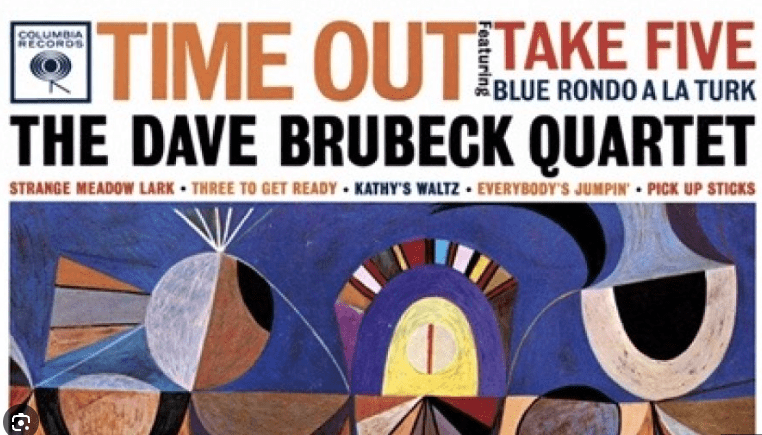Album: Time Out (1959)
Artist: Dave Brubeck Quartet
Cool jazz is a style of modern jazz music inspired by bebop and big bands that arose in the United States after World War II. It is characterized by relaxed tempos and a lighter tone than that used in the fast and complex bebop style.
My top 3 songs from “Time Out” would have to be Take Five which, in my opinion, is not too loud, has smooth beats, and doesn’t have too much going on. The second song would have to be Three to Get Ready, a pretty slow-paced song with light drumming and the piano playing in the back. The bass is also featured pretty heavily in the music. What I like most about the song is when they take pauses to let each instrument play. The third song would have to be Everybody’s jumpin‘; the piano is at a much faster pace beat/ tempo than the other instruments. I also considered that the saxophone might be the “words,” and the bass, piano, and drums follow the lead or are “talking back.”
Tracklist:
- Blue Rondo à la Turk
- Strange Meadow Lark
- Take Five
- Three to Get Ready
- Kathy’s Waltz
- Everybody’s Jumpin’
- Pick Up Sticks
Listening Guide:
- Blue Rondo à la Turk:
- A dynamic opener that blends Turkish rhythms with traditional jazz. Listen to the distinct time signature (9/8) that underlines the unique structure of the piece.
- Pay attention to the interplay between Brubeck’s piano and Paul Desmond’s saxophone, and how they navigate through the complex rhythmic patterns.
- Strange Meadow Lark:
- Immerse yourself in the calming, pastoral ambiance created by the gentle piano chords and the soothing saxophone melody.
- Notice the subtle shifts in the mood of the piece and how the quartet maintains a delicate balance between improvisation and structure.
- Take Five:
- One of the most famous jazz compositions of all time. Listen for the iconic 5/4 time signature and the infectious, unforgettable saxophone melody.
- Appreciate the impeccable improvisational skills of each musician, especially the legendary saxophone performance by Paul Desmond.
- Three to Get Ready:
- Observe the seamless transition between the 3/4 and 4/4 time signatures, highlighting Brubeck’s innovative approach to rhythm.
- Focus on the playful interaction between the instruments, reflecting the light-hearted and jovial mood of the piece.
- Kathy’s Waltz:
- Dive into the graceful and charming waltz rhythm, carried by Brubeck’s piano and supported by the intricate drum work.
- Notice the sophisticated yet accessible nature of the composition, showcasing the Quartet’s ability to create melodic richness within a traditional waltz structure.
- Everybody’s Jumpin’:
- Experience the energetic and upbeat nature of this piece, characterized by the lively interplay between piano and drums.
- Pay attention to the spontaneous and lively improvisational passages that showcase the Quartet’s synergy and musical camaraderie.
- Pick Up Sticks:
- Conclude the album with this dynamic and fast-paced track that demonstrates the Quartet’s technical prowess and virtuosity.
- Notice the intricate synchronization between the instruments, emphasizing the rhythmic complexity and the group’s ability to seamlessly weave together different musical motifs.
“Time Out” remains a significant milestone in the history of jazz, primarily due to its bold experimentation with complex time signatures and the remarkable synergy of the musicians. Enjoy exploring the innovative sounds and the timeless brilliance of the Dave Brubeck Quartet as you listen to this iconic album.


